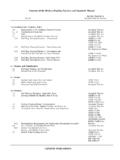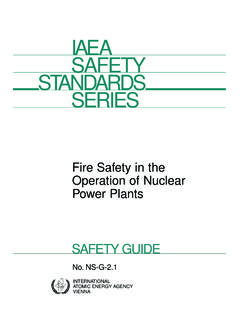Transcription of Good practices protection of witnesses - unodc.org
1 Vienna International Centre, Box 500, 1400 Vienna, AustriaTel.: (+43-1) 26060-0, Fax: (+43-1) 26060-5866, practices for theprotection of witnessesin criminal proceedings involving organized crimePrinted in January 2008 1,000 United Nations Office on Drugs and Crime ViennaUNITED NATIONS New York, 2008 Good practices for the protection of witnesses in Criminal Proceedings Involving Organized 17/1/08 12:11 pm Page 17/1/08 12:11 pm Page iiIn recent years transnational organized crime has grown. Criminal organizations arebecoming stronger and more diverse. They are engaging more and more frequently in systematic forms of cooperation designed to further their criminal activities. In the inves-tigation and prosecution of crime, particularly the more serious and complex forms oforganized crime, it is essential that witnesses , the cornerstones for successful investiga-tion and prosecution, have trust in criminal justice systems.
2 witnesses need to have the confidence to come forward to assist law enforcement andprosecutorial authorities. They need to be assured that they will receive support and pro-tection from intimidation and the harm that criminal groups may seek to inflict upon themin attempts to discourage or punish them from United Nations Convention against Transnational Organized Crime and its Protocols callupon State Parties to introduce appropriate measures to prevent witness intimidation, coer-cion, corruption or bodily injury, and to strengthen international cooperation in this though, even where such measures have been legislated, implementation remains lessthan satisfactory and further progress is needed particularly with regard to cross-bordercooperation especially regarding the change of identity and relocation of at-risk witnesses . Experience has shown that in witness protection there are no easy solutions. However thispublication, developed by the United Nations Office on Drugs and Crime following a seriesof regional meetings with expert representatives from law enforcement, prosecutorial andjudicial authorities, has been designed to assist and support Member States in the estab-lishment and operation of effective witness protection programs.
3 It provides a usefulaccount of available measures and offers practical options suitable for adaptation andincorporation in the legal system, operational procedures and particular social, politicaland economic circumstances of Member am confident that the publication should serve as a useful and valuable tool for policy-makers, legislators, legal practitioners, senior law enforcement and justice officialsinvolved in the protection of witnesses . 17/1/08 12:11 pm Page viiiAntonio Maria CostaExecutive DirectorUnited Nations Office on Drugs and CrimeVienna January 17/1/08 12:11 pm Page ivThe compilation by the United Nations Office on Drugs and Crime ( unodc ) of these good practicesfor the protection of witnesses in criminal proceedings involving organized crime was made possiblethanks to the active support and contributions of dedicated professionals of Member States of theUnited Nations, international criminal tribunals and international organizations involved in thisfield.
4 Their participation in the meetings of the unodc expert groups and their thoughtful commen-tary during the drafting process were a source of inspiration and served to create a text that goesbeyond the usual general theoretical approaches to witness protection and addresses the opera-tional aspects of setting up and implementing witness protection programmes. For security reasons,it is not possible to publish the names of the contributing subject matter experts but unodc extendsto them its appreciation and gratitude. The Good practices for the protection of witnesses in Criminal Proceedings involving OrganizedCrime were produced by the Anti-Trafficking Section of unodc under the supervision of BrianTaylor. The text was prepared by Ilias Chatzis and revised by Karin Kramer. Silke Albert,Demostenes Chryssikos, Stuart Gilman and Filipe De La Torre offered comments, and Nicole Maricand Tejal Jesrani conducted 17/1/08 12:11 pm Page 17/1/08 12:11 pm Page viContentsPreface.
5 IiiForeword .. IInnttrroodduuccttiioonn ..11A. The core issue ..1B. Mandate of the United Nations Office on Drugs and Crime ..1C. The process .. of the good practices .. of the good practices .. pprrootteeccttiioonn:: oorriiggiinnss aanndd sseelleecctteedd aapppprrooaacchheess ..77A. Origins: United States of America ..7B. Witness protection in various countries ..8C. Witness protection at the permanent and ad hoc international criminal courts .. KKeeyy eelleemmeennttss ..1199A. Participants .. 19B. The crime .. MMeeeettiinngg tthhee tthhrreeaatt ..2277A. Witness assistance .. 27B. Alternative measures .. SSeettttiinngg uupp aa wwiittnneessss pprrootteeccttiioonn pprrooggrraammmmee ..4433A. Need versus want .. 43B. Legislation versus policy basis .. 43C. Programme location ..45D. Organizational structure .. 46E.
6 Personnel .. 47F. Funding .. 50G. Principles of operation .. 17/1/08 12:11 pm Page EEnntteerriinngg wwiittnneessss pprrootteeccttiioonn ..5599A. Application .. 59B. Decision-making authority .. 60C. Criteria for admission .. 61D. Memorandum of understanding .. RReessppoonnssiibbiilliittiieess ooff tthhee ppaarrttiieess ..6677A. The protection authority .. 68B. The witness ..71C. Termination of the programme .. RReellooccaattiioonn aanndd iiddeennttiittyy cchhaannggee ..7777A. A new identity .. 77B. International relocation ..82C. Implications of relocation and identity change for the witness .. FFuuttuurree cchhaalllleennggeess ..8899A. New forms of crime .. 89B. A global village .. 89C. Biometrics .. CCoonncclluussiioonn ..9933A. Main elements .. 93B. Alternative measures.
7 94C. Requirements .. 94D. Admission criteria .. 95E. Costs .. 95F. Programme administration .. 95G. International relocation ..95 AAnnnneexxeessI. Consulted national authorities of Member States of the United Nations .. 97II. National legislation .. 101 III. International tribunals .. 103IV. United Nations legal instruments and resolutions on standards and norms related to the protection of witnesses .. 105 Bibliography .. 17/1/08 12:11 pm Page viii1I. IntroductionWhat is witness protection ? What are its main elements? How is it used to strengthencriminal investigations and prosecutions? Are there any universally applicable lessonsthat are the secret to successful witness protection programmes? Can countries with lim-ited human and financial resources afford programmes like the ones operated and prizedby well-funded and well-resourced legal systems?
8 These are some of the questions that thepresent publication seeks to answer. Some answers will come easily. In most cases, how-ever, experience has shown that, in actuality, practice is complicated. A. The core issueThe ability of a witness to give testimony in a judicial setting or to cooperate with lawenforcement investigations without fear of intimidation or reprisal is essential to main-taining the rule of law. Increasingly, countries are enacting legislation or adopting policiesto protect witnesses whose cooperation with law enforcement authorities or testimony ina court of law would endanger their lives or those of their may be as simple as providing a police escort to the courtroom, offering tempo-rary residence in a safe house or using modern communications technology (such asvideoconferencing) for testimony. There are other cases, though, where cooperation by awitness is critical to successful prosecution but the reach and strength of the threateningcriminal group is so powerful that extraordinary measures are required to ensure the witness s safety.
9 In such cases, resettlement of the witness under a new identity in a new, undisclosed place of residence in the same country or even abroad may be the onlyviable alternative. B. Mandate of the United Nations Office on Drugs and CrimeUnder article 24 of the United Nations Convention against Transnational Organized Crime(General Assembly resolution 55/25, annex I), States parties are to take appropriate meas-ures to provide effective protection from retaliation or intimidation for witnesses who givetestimony in cases involving transnational organized crime. The measures envisagedinclude physical protection , the relocation and non-disclosure or limitations on the disclo-sure of the identity and whereabouts of the witness and the introduction of evidentiaryrules to permit testimony to be given in a manner that ensures the witness s safety. Statesparties are to consider entering into agreements or arrangements with other States for therelocation of witnesses (para.)
10 3). The provisions of the article apply also to victims insofaras they are witnesses (para. 4). 17/1/08 12:11 pm Page 1 Under article 26 of the Organized Crime Convention, States parties are required to takeappropriate measures to encourage persons who participate or have participated inorganized criminal groups to cooperate with law enforcement authorities for investigativeand evidentiary purposes. Pursuant to paragraph 4 of that article, such persons are to beafforded protection in accordance with the provisions of article protection of victims and/or witnesses is also explicitly addressed in the protocols tothe Organized Crime Convention, specifically in the Protocol to Prevent, Suppress andPunish Trafficking in Persons, Especially Women and Children, supplementing the UnitedNations Convention against Transnational Organized Crime (General Assembly resolution55/25, annex II, articles 6 and 7) and the Protocol against the Smuggling of Migrants byLand, Sea and Air, supplementing the United Nations Convention against TransnationalOrganized Crime (Assembly resolution 55/25, annex III, articles 5 and 16).











